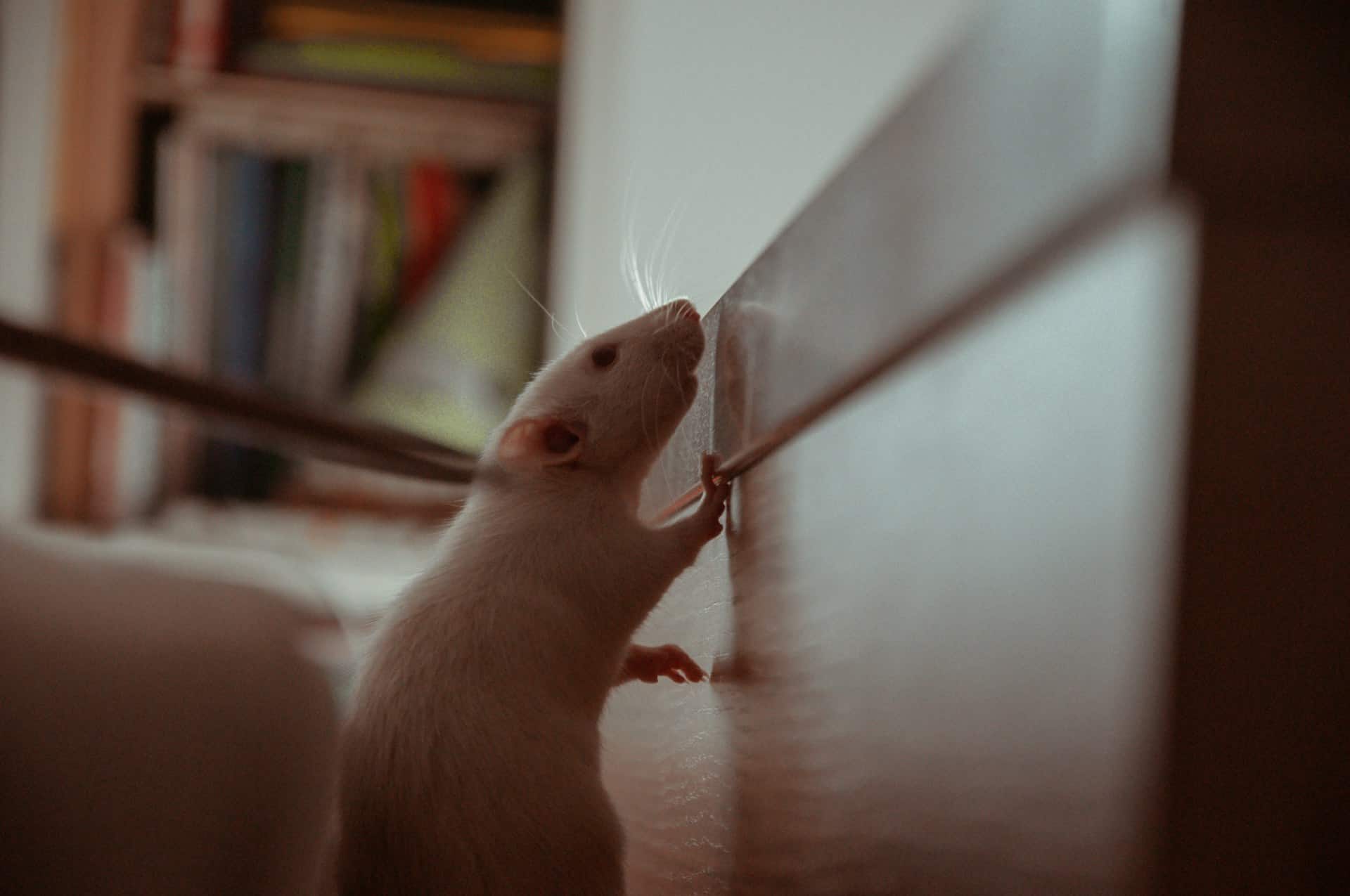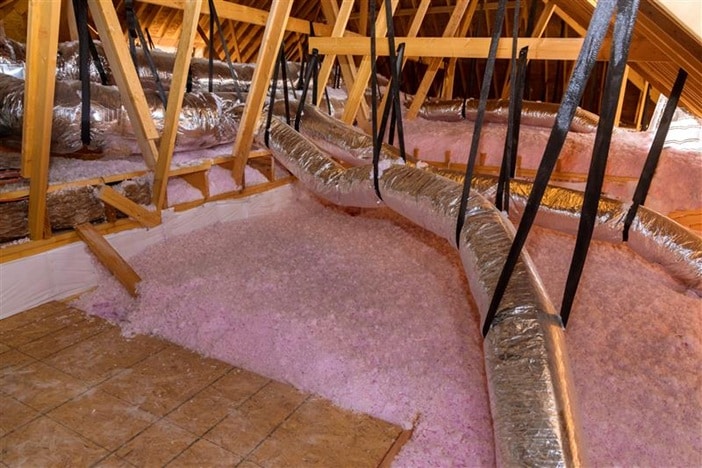
Mice will go into any type of home or building that has access points for them, including cracks and crevices, vents, and holes. They prefer warm, dark, and sheltered areas, such as wall cavities, attics, basements, and storage sheds.
Mice are drawn to attics as a source of warmth, shelter, and food. Mice also like to build nests in the insulation, cardboard boxes, and other soft materials, making the attic a perfect habitat. They often enter homes through small holes no bigger than a dime. Eaves, cracks in the exterior walls, vents along the roofline, and utility access points are easy to access entry points.
In most cases, mice are nocturnal, which means they usually remain in their nest during the day. A mouse can venture out at night to search for food. If a mouse has been disturbed and feels uncertain or threatened, it may move out of the attic during the day.
Signs of Mice in the Attic
Homeowners can tell if there are mice in the attic by paying attention to certain sights, sounds, and smells.
- Sounds of mice are scurrying, pattering, rustling sounds as they move, and small squeaking noises.
- Musky odors can be a sign of mice or a strong smell of ammonia from mouse droppings
- Visual evidence of a mouse infestation includes: mouse droppings, urine stains, smudge marks, wood shavings, and mouse nests woven together from shredded fibers.
A mouse will typically build its nest by first collecting soft material such as grass, feathers, and shredded paper to create bedding. The material is then formed into a loose ball and placed in a safe area, such as in a corner of a room, behind furniture, or in a garage. The mouse will then gather more material to reinforce the exterior, often using pieces of cloth, string, or leather to construct a thick wall. Finally, the nest is typically made waterproof by using small amounts of mud or saliva and may be lined with fur or other soft material for added warmth.
Mouse Damage in the Attic
Mice in the attic can cause significant damage by gnawing on the structure of the house, ruining insulation, and chewing on electrical wires. There are health risks with a mouse infestation. They spread their feces and urine wherever they are active. Mouse droppings and urine will soil attic insulation. They will contaminate food sources and water sources with harmful diseases such as tularemia, leptospirosis, Hantavirus, and salmonellosis. Their presence also brings additional pests, such as fleas and ticks, into the home.
Mouse Removal from Attic
Although there are many commercially available mouse traps for homeowners to use in their removal efforts, DIY attempts at mouse control often fail or even make the situation worse. To get rid of mice in the attic, contact the pest control specialists at Critter Control.
Attic Remediation after Mouse Infestation

Why Attic Remediation Is Important
Rodents in attics are a serious problem and often leave major damage behind in their wake. After ridding your attic of their presence, it’s important to complete proper attic remediation because of the potential:
- Health risks: Rodents carry various disease-inducing organisms, such as hantavirus, leptospirosis, and salmonella, which can be transmitted through their droppings to your pets and loved ones. Additionally, their feces and urine can cause respiratory ailments and allergies for you and your family.
- Structural damage: To gain entry to your attic and build cozy nests for their young, rodents will chew on wood, wiring, and insulation. They’ll gnaw through nearly anything in their way, causing fire hazards and compromising the structure of your attic.
- Re-infestations: Leftover nests and droppings may attract other pests, including insects and new rodents, opening the door to recurring infestations.
Our experienced team at Critter Control provides professional attic remediation services after rodent infestations to restore your attic to its clean, rodent-free state. This process includes:
Inspection
First, we thoroughly check your attic to determine:
- Rodent activity.
- The extent of damage from animals to insulation, wiring, or wood.
- Potential entry points rodents may use to enter the attic.
This gives our team a better idea of what we’re dealing with, ensuring we can effectively address all problems before beginning remediation.
Clean Up
Rodent infestations leave behind contaminated materials that must be carefully removed. Our cleanup process includes:
- Safely disposing of nesting materials and rodent droppings.
- Using specialized sanitizers, such as industrial-grade disinfectants, to disinfect the area.
- Eliminating harmful bacteria and odors to make your attic a safe environment once more.
Remove and Replace Insulation
Your uninvited attic guests may damage insulation during their stay, nesting in it and contaminating it with urine and droppings. During our inspection, we’ll evaluate the insulation and replace it if necessary. Generally, we recommend replacement when:
- Areas are heavily contaminated with rodent waste.
- Insulation has suffered significant water damage.
- Insulation is old and no longer effective.
- There are signs of mold or mildew growth.
We can help prepare insurance bids for insulation replacement to ensure a seamless transition. We work with most major insurance companies to ease the financial burden.
TAP Pest Control Insulation
As part of the remediation process, we offer Thermal Acoustical Pest (TAP) Control Insulation. This is a specialized insulation that offers multiple advantages over run-of-the-mill insulation, including:
- Pest resistance: TAP insulation is infused with boric acid, which deters insects and other pests.
- Energy efficiency: It helps with temperature regulation, adding a layer of insulating protection that reduces heating and cooling costs.
- Noise reduction: TAP insulation offers superior soundproofing compared to traditional insulation, helping keep your home quieter and more comfortable.
We install TAP insulation to provide long-term protection against future infestations while improving energy efficiency and reducing noise.
Seal Entry Points
Preventing future rodent infestations requires sealing all entry points. Since rodents can squeeze through incredibly small spaces, we use various materials depending on the size of the opening:
- For small gaps: Steel wool, mesh, or caulk
- For larger holes: Cement, metal, or hardware cloth
These materials serve as rodent deterrents, effectively preventing the critters from squeezing through. We choose the most appropriate material based on the location and size of the gap to ensure long-term protection against uninvited creatures.
Contact Critter Control Today
If you suspect you have a rodent infestation or need help getting rid of one, our experienced team at Critter Control is here to help. We’re experts in safely and humanely eliminating pest infestations, including rodent infestations, in attics. After eliminating the problem, we won’t leave your attic in shambles—we’re experts in attic remediation, too.
We will clean and re-insulate your attic to restore it to its former safe, clean, and insulated state, sealing entry points to prevent the problem from recurring. So, if you’re wondering how to get rid of rodents in the attic or need attic remediation after an infestation, you can trust us to get the job done right the first time.
Call Critter Control today to schedule an appointment with the best rodent control service near you, and restore your attic to its best state. Start with a personalized quote for your rodent removal and attic remediation services. Our expert animal removal technicians will eliminate nuisance mice. We will block all mice entry points, employ a strategic rodent trapping program, and clean up the damage caused by mice.
.
Get them out.
Keep them out.®
Experiencing a wildlife or pest issue? We can help! Complete this form and your local Critter Control® office will contact you to assist.
- Baby Mice
- Dead Mice
- House Mouse Nest
- How to Get Rid of Mice
- Mice Behavior in the Winter
- Fear of Mice
- How to Catch a Mouse
- Life Cycle of a Mouse
- Mice in Crawl Space
- Mice in the House
- Mice in the Walls
- Mice in Yard
- Mice Problems
- Mouse Poop & Droppings
- Mice in Pantry
- Mouse Noises
- Mouse Repellent
- Mouse Tracks
- Mouse Traps & Bait
- Mice vs. Rats
- Types of Mice
- Diseases That Mice Carry
- Mouse Appearance
- Where Do Mice Hide?
- White Footed Mouse Habitat